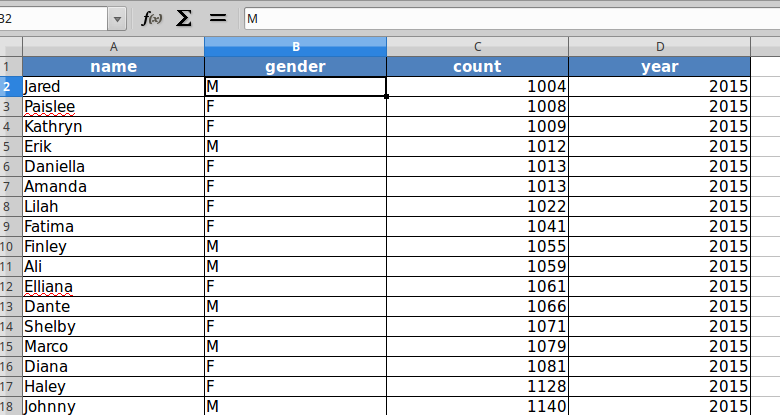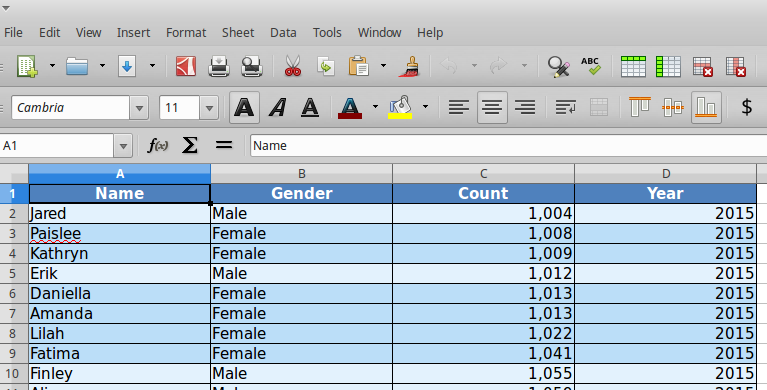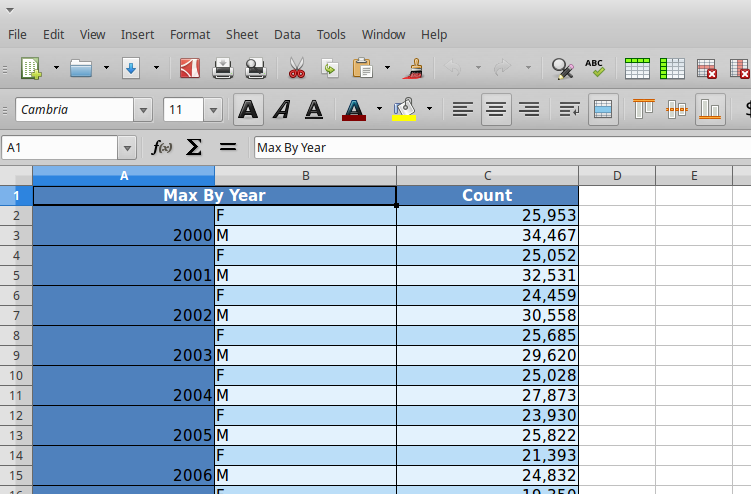XLSX Examples¶
This page provides a list of examples that demonstrate rendering xlsx output from the given dataframe. Each example is self-contained inside a class. We have some helper functions to provide the data we need for this examples
All examples listed in this section use OpenPyxlStyleHelper and OpenPyxlCompositor. To use the xlsxwriter library replace these with XlsxWriterStyleHelper and XlsxWriterCompositor respectively.
If the callback funcs do not use the *StyleHelpers and return their own Style objects then the objects returned should be compatible with the value engine provided to the engine attribute.
Examples of relevant style objects can be found respective documentations for the engine being used.
Helper Functions (Data loading routines)¶
1 2 3 4 5 6 7 8 9 10 11 12 | import tempfile
import zipfile
import collections
import os
import webbrowser
import requests
import pandas as pd
import table_compositor.table_compositor as tc
import table_compositor.xlsx_writer as xlsxw
import table_compositor.xlsx_styles as xlsstyle
|
1 2 3 4 5 6 7 8 9 10 11 12 13 14 15 16 17 18 19 20 21 22 23 24 25 26 27 28 29 30 31 32 33 34 35 36 37 38 39 40 | # code snippet adapted from http://function-pipe.readthedocs.io/en/latest/usage_df.html
# source url
URL_NAMES = 'https://www.ssa.gov/oact/babynames/names.zip'
ZIP_NAME = 'names.zip'
def load_names_data():
fp = os.path.join(tempfile.gettempdir(), ZIP_NAME)
if not os.path.exists(fp):
r = requests.get(URL_NAMES)
with open(fp, 'wb') as f:
f.write(r.content)
post = collections.OrderedDict()
with zipfile.ZipFile(fp) as zf:
# get ZipInfo instances
for zi in sorted(zf.infolist(), key=lambda zi: zi.filename):
fn = zi.filename
if fn.startswith('yob'):
year = int(fn[3:7])
df = pd.read_csv(
zf.open(zi),
header=None,
names=('name', 'gender', 'count'))
df['year'] = year
post[year] = df
df = pd.concat(post.values())
df.set_index('name', inplace=True, drop=True)
return df
def sample_names_data():
df = load_names_data()
df = df[(df['year'] == 2015) & (df['count'] > 1000)]
return df.sample(100, random_state=0).sort_values('count')
def top_names_for_year(year=2015, gender='F', top_n=5):
df = load_names_data()
df = df[(df['year'] == year) & (df['gender'] == gender)]
df = df.sort_values('count')[:top_n]
return df
|
Example 1 - DataFrame with default styles¶
Demonstrates converting dataframe into html format with default styles.
1 2 3 4 5 6 7 8 9 10 11 12 13 14 15 16 17 18 19 20 21 22 | class XLSXExample1:
'''
Demonstrates rendering a simple dataframe to a xlsx file
using the default styles
'''
@classmethod
def render_xlsx(cls):
'''
Render the df to a xlsx file.
'''
# load data
df = sample_names_data()
# build presentation model
pm = tc.build_presentation_model(df=df, output_format='xlsx')
# render to xlsx
tempdir = tempfile.gettempdir()
fp = os.path.join(tempdir, 'example1.xlsx')
layout = [pm]
print('Writing to ' + fp)
xlsxw.OpenPyxlCompositor.to_xlsx(layout=layout, output_fp=fp)
|

Example 2 - DataFrame with custom styles¶
In this example, we format the different components of dataframe with various styling attributes
1 2 3 4 5 6 7 8 9 10 11 12 13 14 15 16 17 18 19 20 21 22 23 24 25 26 27 28 29 30 31 32 33 34 35 36 37 38 39 40 41 42 43 44 45 46 47 48 49 50 51 52 53 54 55 56 57 58 59 60 61 62 63 64 65 66 67 68 69 70 71 72 73 74 75 76 77 78 79 80 81 82 83 84 85 86 87 | class XLSXExample2:
'''
Demonstrates using call-backs that help set the display and style
properties of each cell in the xlsx sheet.
'''
@staticmethod
def data_value_func(df):
def _inner(idx, col):
if col == 'gender':
if df.loc[idx, col] == 'F':
return "Female"
return 'Male'
return df.loc[idx, col]
return _inner
@staticmethod
def data_style_func(df):
def _inner(idx, col):
bg_color = None
number_format='General'
if col == 'count':
number_format='#,##0'
if df.loc[idx, 'gender'] == 'F':
bg_color = 'bbdef8'
else:
bg_color = 'e3f2fd'
return xlsstyle.OpenPyxlStyleHelper.get_style(
bg_color=bg_color,
number_format=number_format)
return _inner
@staticmethod
def index_name_value_func(value):
return value.capitalize()
@staticmethod
def index_name_style_func(value):
return xlsstyle.OpenPyxlStyleHelper.default_header_style()
@staticmethod
def header_value_func(node):
return node.value.capitalize()
@staticmethod
def header_style_func(node):
return xlsstyle.OpenPyxlStyleHelper.default_header_style()
@staticmethod
def index_value_func(node):
return node.value.capitalize()
@staticmethod
def index_style_func(df):
def _inner(node):
bg_color = None
if df.loc[node.value, 'gender'] == 'F':
bg_color = 'bbdef8'
else:
bg_color = 'e3f2fd'
return xlsstyle.OpenPyxlStyleHelper.get_style(bg_color=bg_color)
return _inner
@classmethod
def render_xlsx(cls):
# load data
df = sample_names_data()
# build presentation model
klass_ = XLSXExample2
pm = tc.build_presentation_model(
df=df,
output_format='xlsx',
data_value_func=klass_.data_value_func(df),
data_style_func=klass_.data_style_func(df),
header_value_func=klass_.header_value_func,
header_style_func=klass_.header_style_func,
index_style_func=klass_.index_style_func(df),
index_value_func=klass_.index_value_func,
index_name_style_func=klass_.index_name_style_func,
index_name_func=klass_.index_name_value_func)
# render to xlsx
tempdir = tempfile.gettempdir()
fp = os.path.join(tempdir, 'example2.xlsx')
layout = [pm]
print('Writing to ' + fp)
xlsxw.OpenPyxlCompositor.to_xlsx(layout=layout, output_fp=fp)
|

Example 3 - Simple DataFrame with Layouts¶
Demonstrates rendering multi-dataframes in one worksheet along with common functions for styling
1 2 3 4 5 6 7 8 9 10 11 12 13 14 15 16 17 18 19 20 21 22 23 24 25 26 27 28 29 30 31 32 33 34 35 36 37 38 39 40 41 42 43 44 45 46 47 48 49 50 51 52 53 54 55 56 57 58 59 60 61 62 63 64 65 66 67 68 69 70 71 72 73 74 75 76 77 78 79 80 81 82 83 84 85 86 87 88 89 90 91 92 93 94 95 96 97 98 99 100 101 102 103 104 105 106 107 108 109 110 111 112 113 114 115 | class XLSXExample3:
'''
Demonstrates using call-backs and also rendering multiple tables to single
worksheet.
'''
@staticmethod
def data_value_func(df):
def _inner(idx, col):
if col == 'gender':
if df.loc[idx, col] == 'F':
return "Female"
return 'Male'
return df.loc[idx, col]
return _inner
@staticmethod
def data_style_func(df):
def _inner(idx, col):
bg_color = None
number_format='General'
if col == 'count':
number_format='#,##0'
if df.loc[idx, 'gender'] == 'F':
bg_color = 'bbdef8'
else:
bg_color = 'e3f2fd'
return xlsstyle.OpenPyxlStyleHelper.get_style(
bg_color=bg_color,
number_format=number_format)
return _inner
@staticmethod
def index_name_value_func(value):
return value.capitalize()
@staticmethod
def index_name_style_func(value):
return xlsstyle.OpenPyxlStyleHelper.default_header_style()
@staticmethod
def header_value_func(node):
return node.value.capitalize()
@staticmethod
def header_style_func(node):
return xlsstyle.OpenPyxlStyleHelper.default_header_style()
@staticmethod
def index_value_func(node):
return node.value.capitalize()
@staticmethod
def index_style_func(df):
def _inner(node):
bg_color = None
if df.loc[node.value, 'gender'] == 'F':
bg_color = 'bbdef8'
else:
bg_color = 'e3f2fd'
return xlsstyle.OpenPyxlStyleHelper.get_style(bg_color=bg_color)
return _inner
@classmethod
def render_xlsx(cls):
# Prepare first data frame (same as in render_xlsx)
df = sample_names_data()
# build presentation model
klass_ = XLSXExample3
pm_all = tc.build_presentation_model(
df=df,
output_format='xlsx',
data_value_func=klass_.data_value_func(df),
data_style_func=klass_.data_style_func(df),
header_value_func=klass_.header_value_func,
header_style_func=klass_.header_style_func,
index_style_func=klass_.index_style_func(df),
index_value_func=klass_.index_value_func,
index_name_style_func=klass_.index_name_style_func,
index_name_func=klass_.index_name_value_func)
male_df = top_names_for_year(gender='M')
pm_top_male = tc.build_presentation_model(
df=male_df,
output_format='xlsx',
data_value_func=klass_.data_value_func(male_df),
data_style_func=klass_.data_style_func(male_df),
header_value_func=klass_.header_value_func,
header_style_func=klass_.header_style_func,
index_style_func=klass_.index_style_func(male_df),
index_value_func=klass_.index_value_func,
index_name_style_func=klass_.index_name_style_func,
index_name_func=klass_.index_name_value_func)
female_df = top_names_for_year(gender='F')
pm_top_female = tc.build_presentation_model(
df=female_df,
output_format='xlsx',
data_value_func=klass_.data_value_func(female_df),
data_style_func=klass_.data_style_func(female_df),
header_value_func=klass_.header_value_func,
header_style_func=klass_.header_style_func,
index_style_func=klass_.index_style_func(female_df),
index_value_func=klass_.index_value_func,
index_name_style_func=klass_.index_name_style_func,
index_name_func=klass_.index_name_value_func)
layout = [pm_all, [pm_top_female, pm_top_male]]
# render to xlsx
tempdir = tempfile.gettempdir()
fp = os.path.join(tempdir, 'example3.xlsx')
print('Writing to ' + fp)
xlsxw.OpenPyxlCompositor.to_xlsx(layout=layout, output_fp=fp, orientation='horizontal')
|

Example 4 - DataFrames with Multi-hierarchical columns and indices¶
Demonstrates rendering dataframes with multi-hierarchical indices and mult-hierarchical columns
1 2 3 4 5 6 7 8 9 10 11 12 13 14 15 16 17 18 19 20 21 22 23 24 25 26 27 28 29 30 31 32 33 34 35 36 37 38 39 40 41 42 43 44 45 46 47 48 49 50 51 52 53 54 55 56 57 58 59 60 61 62 63 64 65 66 67 68 69 70 71 72 73 74 75 76 77 78 79 80 81 82 83 84 85 | class XLSXExample4:
'''
Demonstrate styling and rendering of multi-hierarchical indexed dataframe
into a xlsx file.
'''
@staticmethod
def data_style_func(df):
def _inner(idx, col):
bg_color = None
number_format = 'General'
if col == 'count':
number_format = '#,##0'
if idx[1] == 'F':
bg_color = 'bbdef8'
else:
bg_color = 'e3f2fd'
return xlsstyle.OpenPyxlStyleHelper.get_style(
bg_color=bg_color,
number_format=number_format)
return _inner
@staticmethod
def index_name_value_func(value):
return 'Max By Year'
@staticmethod
def index_name_style_func(value):
return xlsstyle.OpenPyxlStyleHelper.default_header_style()
@staticmethod
def header_value_func(node):
return node.value.capitalize()
@staticmethod
def header_style_func(node):
return xlsstyle.OpenPyxlStyleHelper.default_header_style()
@staticmethod
def index_value_func(node):
if isinstance(node.value, str):
return node.value.capitalize()
return node.value
@staticmethod
def index_style_func(df):
def _inner(node):
bg_color = None
if len(node.key) == 1:
bg_color = '4f81bd'
elif node.key[1] == 'F':
bg_color = 'bbdef8'
else:
bg_color = 'e3f2fd'
return xlsstyle.OpenPyxlStyleHelper.get_style(bg_color=bg_color)
return _inner
@classmethod
def render_xlsx(cls):
# Prepare first data frame (same as in render_xlsx)
data_df = load_names_data()
data_df = data_df[data_df['year'] >= 2000]
g = data_df.groupby(('year', 'gender'))
df = g.max()
klass_ = cls
pm = tc.build_presentation_model(
df=df,
output_format='xlsx',
#data_value_func=None, # use default
data_style_func=klass_.data_style_func(df),
header_value_func=klass_.header_value_func,
header_style_func=klass_.header_style_func,
index_style_func=klass_.index_style_func(df),
index_value_func=klass_.index_value_func,
index_name_style_func=klass_.index_name_style_func,
index_name_func=klass_.index_name_value_func)
layout = [pm]
# render to xlsx
tempdir = tempfile.gettempdir()
fp = os.path.join(tempdir, 'example4.xlsx')
print('Writing to ' + fp)
xlsxw.OpenPyxlCompositor.to_xlsx(layout=layout, output_fp=fp, orientation='horizontal')
|
